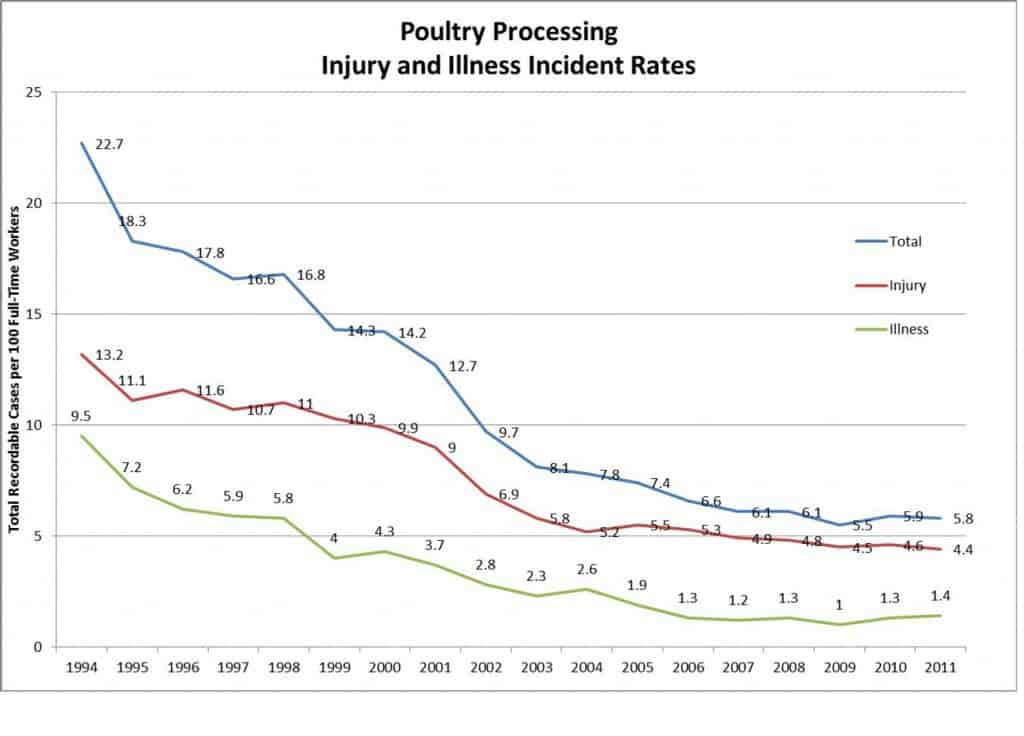Injury and Illness rates down from year ago and down 74 percent since 1994
WASHINGTON, D.C. – The incidence of nonfatal occupational injuries and illnesses in the poultry sector, which includes slaughter and processing, continues to decline, according to the 2011 Injury and Illness Report recently released by the Department of Labor’s Bureau of Labor Statistics (BLS).
The total recordable poultry processing illness and injury rate for 2011 was 5.8 cases per 100 full-time workers (per year), down from 5.9 in 2010. In terms of injuries per 100 full time workers, the poultry industry’s rate of 5.8 was below the rate of 6.4 for all animal slaughter and processing and only slightly above the rate of 5.6 for the entire food manufacturing sector.
Poultry processing’s 2011 rate of 5.8 represents a 74 percent decrease from 1994 (the oldest data available on the BLS website), when the recorded rate was 22.7, demonstrating the enormous progress the industry has made in improving safety for its workforce.
“The significant and consistent decline in illness and injury rates among our workforce over the past two decades is a direct result of the poultry industry’s strong commitment to worker safety,” said National Chicken Council President Mike Brown. “Our employees are our most important asset. I commend poultry companies and their management teams for their tremendous efforts to protect them and for their ongoing dedication to further progress.”
John Starkey, president of U.S. Poultry & Egg Association, commented, “The industry recognizes that our people are our most valuable asset, and worker safety efforts have never been stronger. Poultry companies continue to devote people, time and other resources to actively identify and correct workplace hazards.”
“The poultry industry has been diligent in reducing recordable injuries and illnesses for decades,” said National Turkey Federation President Joel Brandenberger. “This most recent data acknowledges the excellent safety performance achievements the poultry industry has accomplished. We all continue to learn additional practices and tools to further protect the people that work hard every day in our plants to provide high-quality, safe and nutritious protein for consumers.”
A recent economic impact study found that poultry production and processing is directly responsible for 327,400 jobs in the United States.
Ongoing efforts to improve the poultry industry’s record in worker safety include:
- Sharing non-competitive practices, culminating with the release of a whitepaper, Ergonomics in the Poultry Industry – A Review of 25 Years of Industry Efforts, which documents many of the industry’s efforts to improve worker safety;
- Partnering with the Georgia Tech Research Institute to develop an instrument to assess musculoskeletal disorder (MSD) risks in poultry tasks. The tool will measure upper extremity stresses associated with poultry deboning and cutting tasks, and provide quantitative data to help in workstation and tool redesign and process workflow improvements to reduce the stresses and strains associated with repetitive work;
- Continuing to work with equipment manufacturers and suppliers to improve machine guarding on new equipment and the provision of adequate disconnects to assist and facilitate proper lock out/tag out (LOTO) procedures;
- Collaborating with personal protective equipment suppliers. This has led to improvements in cut resistance of protective handwear, reduced fogging issues with safety eyewear, and improved slip resistance in safety footwear to address lacerations, foreign objects/splashes and slip, trips and falls;
- Conducting monthly meetings of the Poultry Industry Safety & Health Committee to share best practices in hazard identification and risk control; and
- Holding an annual safety conference for the past 29 years – the National Safety Conference for the Poultry Industry. The June 2012 conference highlighted such things as “recognizing combustible dust hazards,” “hot topics in industrial hygiene” and roundtable discussions covering many topics including machine guarding, fall protection and catastrophic event planning and response.




